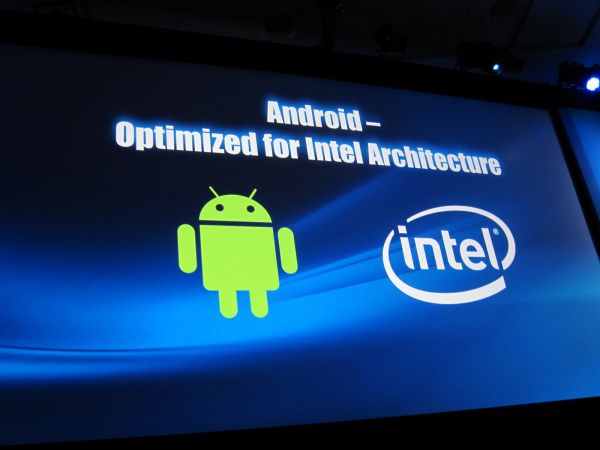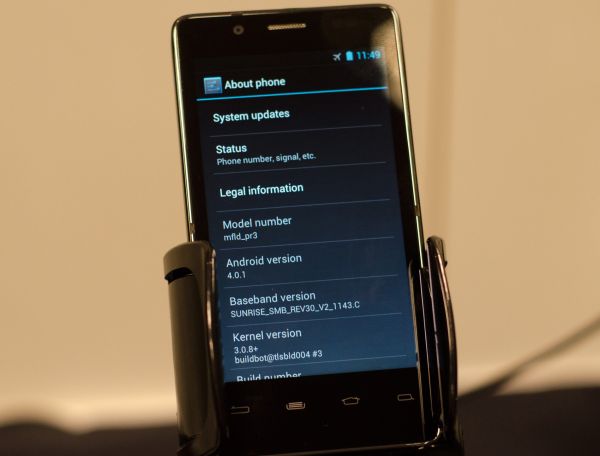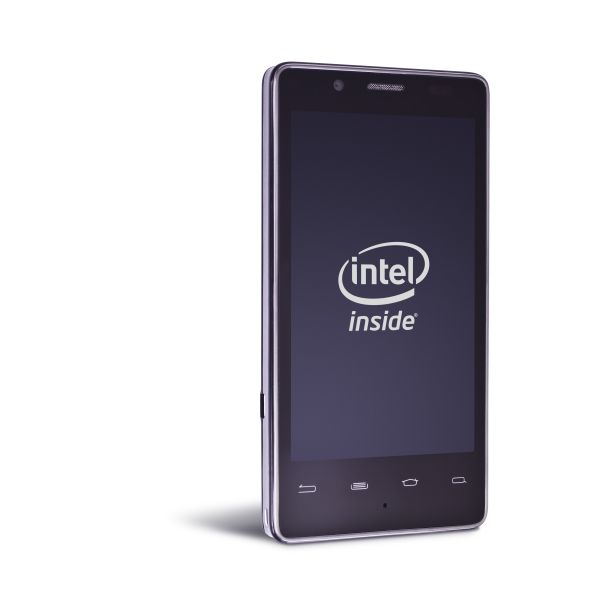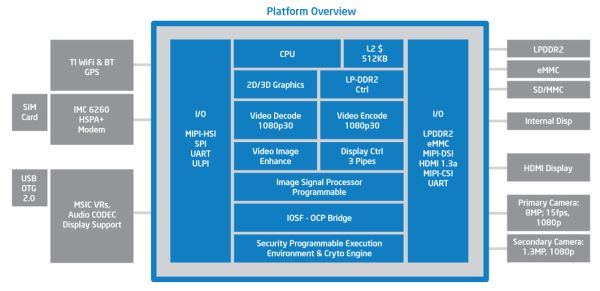Intel's Medfield & Atom Z2460 Arrive for Smartphones: It's Finally Here
by Anand Lal Shimpi on January 10, 2012 8:00 PM ESTWhat's Different This Time Around: Google & A Sweet Reference Platform
Intel has been talking about getting into smartphones for a couple of years now, but thus far it hasn't been able to secure a single design or partnership that that resulted in a product actually coming to market. This time around, things are different. The major change? Focus, and Google.
Intel originally had ambitions of enabling its own mobile OS with the help of Nokia (Moblin/MeeGo). Intel also wanted to support Android as well, however its attention was clearly more focused on the Moblin/MeeGo effort. Similar to the wake up call that pushed NVIDIA to focus exclusively on Android, Intel has now done the same.
At IDF last year Intel and Google announced a partnership and the intention to bring all future versions of Android, starting with Gingerbread, to x86. Since then Intel has ramped up the software engineering engine, going into the Android source code (Gingerbread, Honeycomb and now ICS) and fixing bugs. Intel's goal is to deliver the most stable version of Android as a result of its efforts. Intel is also submitting its changes upstream to the AOSP, which should help improve the Android experience even on ARM platforms.
Under the leadership of Mike Bell (formerly of Apple and Palm), Intel has also created an extremely polished Medfield reference design. This is the same design shown off at IDF last year (apparently there's an even thinner one floating around somewhere), but what separates it from other reference designs we've seen from SoC vendors is that the Medfield reference platform was designed to be a polished phone that could theoretically be rebranded and resold.
Intel knew the onus was on itself to prove that Medfield, Atom and even just x86 was power efficient enough to be delivered in a compelling form factor with competitive battery life. Paul Otellini gave Mike carte blanche access to any of Intel's resources. Instead of having to work with existing Intel groups, Mike was allowed to assemble his dream team of engineers. The team Mike built is what he felt he needed to not only bring Medfield to market, but also to build the a first class Atom based smartphone.
The result is this:
Internally it features Intel's own XMM 6260 HSPA+ modem. Intel claims LTE is on the way although there's no ETA on that.
WiFi in the reference design is provided by TI's 1283 controller. Intel's wireless team does not have a a WiFi solution that's low power enough to work in a smartphone, although after the recent restructuring the team has now been tasked with building an ultra low power solution that can.
The display is a somewhat unusual 1024 x 600 panel, with support for 1080p30 (and 1080i60) output via HDMI. The SoC specs are identical to what I've already discussed: 1.6GHz max CPU clock and a 400MHz GPU clock.
The reference platform is not only smartphone sized, but Intel has built its own qualification labs that mirror those of the carriers to ensure quality and convince its customers of the platform's legitimacy. In essence, Intel has built its own miniature smartphone design and test center.
The Medfield reference platform is available for use by any of Intel's customers, and indeed that's what's already happening. Lenovo's K800 is based on a modified version of Intel's reference platform, and I wouldn't be surprised if more aren't on the way.
All of this sounds a lot like Intel's efforts in the motherboard space over a decade ago where it started providing motherboard manufacturers with reference designs that they could modify if they desired. The effort helped significantly reduce time to market and allowed the motherboard makers to focus more on specializing on what they were good at.
The Medfield reference platform is designed to do the very same for smartphones. Intel wants to provide its partners with a well designed, stable smartphone platform. If they choose to use it, they can shave off a significant amount of development time and spend more of their time on software or simply bring a good reference phone to market in a quick fashion. I'm not entirely sure I've seen many players in the Android space that are actually all that great at software development, but Intel believes anything that shortens time to market will be appreciated.
I asked Intel if it has any plans to offer the reference platform unlocked, direct to customers. Unfortunately the answer at this point is still no. I suspect that Intel is more interested in building its customer base rather than circumventing it.
















164 Comments
View All Comments
mrtanner70 - Wednesday, January 11, 2012 - link
I am a long time fan of the site and still think your actual product testing is the best. However over the last year or so there has been a noticeable pattern of really being a bit too enthusiastic toward Intel PR and spin. I would like to see a little bit more intelligent skepticism when dealing with Intel reference designs and slide decks.Lucian Armasu - Thursday, January 12, 2012 - link
I have to agree, about Intel spinning stuff more and more lately, too. I've noticed it since they announced the "3D" chips. Everyone reacted as if the 3D are 10x better than SNB or whatever, when in fact that's not true. The 3D chips have only +37% performance at the same power level, OR -50% power consumption at the same performance level. That's barely as news worthy as they made it sound. They put 1 extra year ahead of AMD at most on top of the 6 months difference they already have now.So I don't know how everyone got from that that now that they have that they will be able to compete with ARM, which ARM at the same performance has much better power efficiency and also costs several times less.
Hector2 - Thursday, January 12, 2012 - link
What you said is about right for "active" power. A couple of things not mentioned is that the 22nm chip will be quite a bit smaller than 32nm (meaning even lower cost) and that the FinFET transistors drop the "standby" power by a factor of 10X-20X lower than even the 32nm version.As was said somewhere, Medfield gets Intel's foot in the door with a competitive product --- and I think most here will agree that it's at least competitive. Certainly, Intel's new partners must think so. The coming of the 22nm upgrade in 2013 is where it really gets interesting.
It's taken Intel awhile to carve out a viable single chip design that's product-worthy. Now that they have one, I expect them to march with the same tick-tock cadence that they've driven the PC market with -- and they already have working 3D FinFET 14nm chips in the lab.
Finally - Thursday, January 12, 2012 - link
Mark my words:The day that AnandTech welcomes a revolutionary AMD product (think e.g. Brazos II) with the words "It's finally here" will be the very day hell freezes over.
Hector2 - Thursday, January 19, 2012 - link
Hmmm. When do you think AMD might be entering the smartphone market ?thunng8 - Wednesday, January 11, 2012 - link
That intel graph for graphics performance is way off and misleading.If one of the smartphones tested is the iphone4S, then that phone should have >2x performance advantage in graphics compared to Medfield reference platform.
solipsism - Wednesday, January 11, 2012 - link
If Medfield is as good as it looks today and they can keep moving along as Cortex-A15 comes along tablets and smartphones could be Intel-based and Apple could be serious trouble by supporting ARM. It could be the whole the PPC issue all over again where Apple will linger for way too long before switching architectures. That's a worse scenario perfect storm, of course, and a long ways off, but it's still something that can't be good for companies with vertical integration with heavy ARM support.markit - Wednesday, January 11, 2012 - link
as infact 2 year old cortex a-9 (even if single cored) outperform it / mhze.g. if i scale down medfields results linearly
(which is imho quite accurate for this benches)
i get:
@1ghz
2130ms and 72766 points
and compare against my old tegra 2 based toshiba ac100 (running ubuntu and chrome 13)
with one core running @ 1 Ghz, and second core turned off i get:
sunspider 1962ms ( per mhz 9% faster)
browsermark 111872 ( per mhz 54% faster as medfield)
so regarding browsermark infact the ac100 nearly matched the 1.6ghz results of this medfield reference plattform while running on only one 1 ghz core,..
btw. both cores turned on and @ 1Ghz:
sunspider 1941 ms
browsermark 114523
so hmm, i think i can guess why intel didn`t choose dual-core friendly benchmarks,..
and remeber the ac100 did hit the stores June 2010!
FunBunny2 - Wednesday, January 11, 2012 - link
I still am puzzled by this. It's been at least a decade since an Intel chip executed X86 code in hardware; the chip is a RISC design fronted by an emulator. Or has Intel gone back to X86 instructions in hardware for these SoC?dealcorn - Thursday, January 12, 2012 - link
Was I deceived? I read about fin-fet and 3d transistors and was impressed because it is credible technology that will permit Intel to do good things before others. That colored my perspective on mobile Atom leading to statements such as "Show time starts at 22 nm." I felt that absent the 3d benefits, Intel would find it tough to go head to head against ARM. While Intel focused attention on 3d, the implication was they are dead in the water until 22nm arrives.That is wrong. Mobile Atom is never going to be built using 22nm transistors. It will be built using 22nm LP transistors. Furthermore, it appears that 32nm LP transistor get the job done just fine (even if 32 nm is worthless in this context). Is 32nm LP the secret sauce that lets it all work? Should the headline have been "Intel's process advantage muscle works almost as good at 32 nm LP as it was supposed to work at 22nm."?